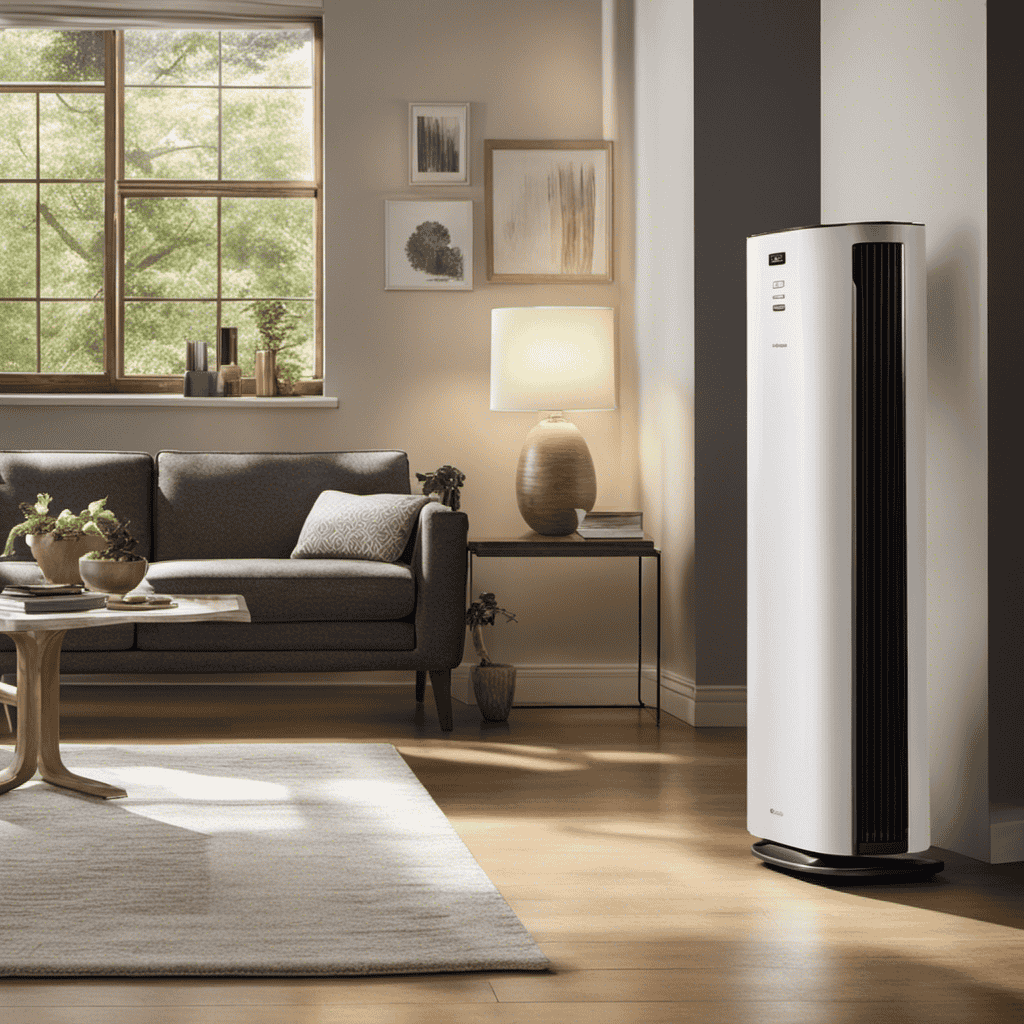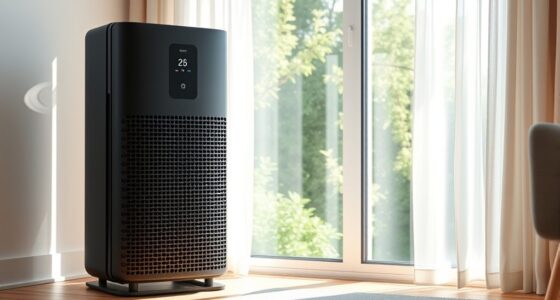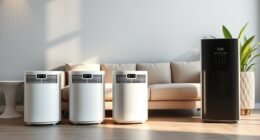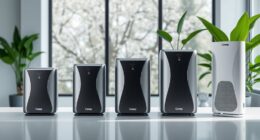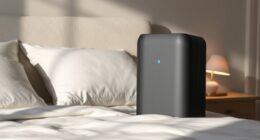As I explore the realm of indoor air quality, I find myself pondering the significance of air purifiers. These devices, with their modern designs and bold promises, have captured my interest. What exactly are their functions? How do they operate?
In this article, I will explore the health benefits of air purifiers, their role in removing indoor air pollutants, and their impact on allergy relief and asthma management. Join me on this journey as we uncover the true purpose and potential of air purifiers.
Key Takeaways
- Removes harmful pollutants from the air
- Improves respiratory health
- Reduces the risk of respiratory diseases and allergies
- Provides cleaner and fresher air
Health Benefits of Using an Air Purifier
Using an air purifier can greatly improve your health by removing harmful pollutants from the air you breathe. Air purifiers play a crucial role in maintaining respiratory health and improving indoor air quality.
Research has shown that indoor air can be more polluted than outdoor air, containing various pollutants such as dust, pet dander, pollen, and volatile organic compounds (VOCs). These pollutants can have a detrimental effect on respiratory health, causing symptoms such as coughing, wheezing, and shortness of breath.
However, air purifiers are designed to filter out these harmful particles, providing cleaner and fresher air. By eliminating these pollutants, air purifiers can significantly reduce the risk of respiratory diseases and allergies, leading to improved overall health and well-being.
Therefore, investing in an air purifier is a wise choice to ensure a healthier living environment.
How Air Purifiers Remove Indoor Air Pollutants
To remove indoor air pollutants, you’ll want to understand how air purifiers work and their ability to filter out harmful particles. Air purifiers play a crucial role in improving indoor air quality and controlling air pollution. They work by drawing in air from the surrounding environment and passing it through a series of filters. These filters effectively capture and remove various pollutants, such as dust, pollen, pet dander, smoke, and volatile organic compounds (VOCs). The effectiveness of an air purifier in removing pollutants depends on its filtration system and the size of the particles it can capture. HEPA (High-Efficiency Particulate Air) filters, for example, can remove particles as small as 0.3 microns with an efficiency of 99.97%. By using air purifiers, you can significantly reduce the presence of indoor air pollutants, leading to improved indoor air quality and healthier living environments.
| Pollutants | Air Purifier Filters | Efficiency |
|---|---|---|
| Dust and Allergens | HEPA Filters | 99.97% |
| Smoke and Odors | Carbon Filters | 99% |
| VOCs and Chemicals | Activated Carbon Filters | 95% |
The Role of Air Purifiers in Allergy Relief
If you suffer from allergies, air purifiers can provide relief. They filter out allergens like dust, pollen, and pet dander. Air purifiers play a crucial role in maintaining respiratory health and controlling indoor pollution.
Here are some reasons why air purifiers are beneficial for allergy sufferers:
-
They remove airborne allergens: Air purifiers are equipped with filters that effectively capture and remove allergens from the air. This reduces exposure and minimizes allergic reactions.
-
They improve indoor air quality: Air purifiers help control indoor pollution. They remove not only allergens but also pollutants like smoke, chemicals, and volatile organic compounds (VOCs). This can significantly reduce the risk of respiratory issues and improve overall respiratory health.
Air Purifiers and Asthma Management
By incorporating an air purifier into your home, you can effectively manage your asthma symptoms and improve your overall respiratory health. Asthma triggers, such as pollen, dust mites, pet dander, and mold spores, can greatly impact the air quality in your home, leading to increased asthma symptoms and decreased lung function.
Air purifiers are designed to filter out these triggers, removing them from the air and reducing their presence in your home. Research shows that using an air purifier can significantly reduce asthma symptoms and improve lung function in individuals with asthma. These devices use filters to capture and trap allergens and irritants, preventing them from circulating in the air you breathe.
Eliminating Odors With an Air Purifier
When it comes to eliminating odors, I’ve found that using an air purifier is an effective technique. Air purifiers are designed to filter out pollutants and particles from the air, including odor-causing molecules.
Through the use of advanced filtration systems, these devices can effectively remove unpleasant smells, leaving the air fresh and clean.
In addition to eliminating odors, the use of air purifiers also offers the added benefit of improving indoor air quality. This has been linked to various health benefits such as reduced respiratory symptoms and improved overall well-being.
Odor Elimination Techniques
You can use activated carbon filters to effectively eliminate unwanted odors with your air purifier. These filters are designed to trap and neutralize odor-causing molecules, providing you with cleaner and fresher indoor air.
When choosing an air purifier for odor elimination, it is important to consider the following:
-
Air purifier technology:
-
Look for air purifiers that use activated carbon filters, as they are specifically designed to target and remove odors from the air.
-
Consider air purifiers with multiple filtration stages, such as a pre-filter, HEPA filter, and activated carbon filter, to ensure thorough odor elimination.
-
Best air purifiers for odor elimination:
-
Research and compare different air purifier brands and models to find the ones that have received positive reviews for odor elimination.
-
Consider the square footage coverage of the air purifier to ensure it is suitable for the size of your room or space.
Air Purifier Effectiveness
To determine the effectiveness of an air purifier, consider factors such as the type of technology used and the overall performance of the device. There are various air purifier technologies available in the market, each with its own advantages and limitations. Some popular air purifier brands include Dyson, Honeywell, and Blueair. These brands utilize different technologies such as HEPA filters, activated carbon filters, and UV-C light to remove particles and pollutants from the air. To compare their effectiveness, I have created a table below:
| Brand | Technology |
|---|---|
| Dyson | HEPA + Activated Carbon |
| Honeywell | HEPA + Pre-filter |
| Blueair | HEPA + Electrostatic |
Benefits of Fresh Air
One of the benefits of breathing in fresh air is that it can improve overall well-being and contribute to a healthier lifestyle. Ventilating indoor spaces is crucial for maintaining good air quality, especially considering the potential harmful effects of indoor air pollution.
Here are a few key benefits of fresh air:
-
Promotes respiratory health:
-
Fresh air helps to dilute and remove indoor pollutants like dust, allergens, and volatile organic compounds (VOCs), reducing the risk of respiratory issues.
-
Increased ventilation can also minimize the spread of airborne viruses and bacteria, leading to fewer respiratory infections.
-
Enhances cognitive function:
-
Studies have shown that increased ventilation and exposure to fresh air can improve cognitive performance, attention span, and productivity.
-
Fresh air provides the brain with the oxygen it needs for optimal functioning, promoting clearer thinking and better decision-making.
Incorporating proper ventilation strategies and regularly bringing in fresh air can significantly improve indoor air quality, leading to numerous health benefits and an overall improved well-being.
Air Purifiers and Pet Dander Control
If you have pets and are concerned about pet dander, an air purifier can help to control and reduce the allergens in your home. Pet hair control is essential for pet owners, as it is a common source of allergens.
Air purifiers specifically designed for pet owners can effectively remove pet dander from the air, improving indoor air quality and reducing allergies. These air purifiers are equipped with specialized filters that can capture and trap pet hair and dander particles, preventing them from circulating in the air.
Additionally, some air purifiers also feature activated carbon filters that can remove pet odors, ensuring a fresher and cleaner environment. Studies have shown that using air purifiers for pet dander control can significantly decrease allergy symptoms and improve respiratory health for both humans and pets.
Air Purifiers for Smoke and VOC Removal
Using an air purifier with a specialized filter can effectively remove smoke and VOCs from the air, improving indoor air quality. Air purifiers designed for smoke and VOC removal are particularly beneficial for individuals with chemical sensitivities or those who live in areas with high levels of air pollution.
Here are some key benefits of using air purifiers for smoke and VOC removal:
-
Reduction of smoke particles: Air purifiers with HEPA filters can capture and remove smoke particles, reducing the unpleasant odor and potential health risks associated with smoke inhalation.
-
VOC removal: Air purifiers equipped with activated carbon filters can effectively trap and eliminate volatile organic compounds (VOCs) released by household products, such as cleaning agents and paint.
Choosing the Right Size and Type of Air Purifier
When selecting the right size and type of air purifier, it’s important to consider the square footage of the room and the specific pollutants you want to target.
To choose the right type of air purifier, you need to understand the different technologies available. HEPA filters are highly effective at removing airborne particles such as dust, pollen, and pet dander. If you are dealing with smoke or volatile organic compounds (VOCs), then an air purifier with an activated carbon filter is the right choice.
When it comes to choosing the size of the air purifier, you need to consider the Clean Air Delivery Rate (CADR) and the Air Changes per Hour (ACH) required for your room size. The CADR indicates how quickly the purifier can clean the air, while the ACH measures how many times the air in the room is filtered per hour.
Maintaining and Cleaning Your Air Purifier
When it comes to maintaining and cleaning your air purifier, there are three key points to consider: filter replacement frequency, proper cleaning techniques, and the benefits of regular maintenance.
First, it is important to understand the recommended filter replacement frequency for your specific air purifier model, as this can vary.
Secondly, knowing the proper cleaning techniques for your unit will ensure its optimal performance and longevity.
Lastly, regular maintenance of your air purifier can provide a range of benefits, such as improved indoor air quality and increased efficiency.
Filter Replacement Frequency
To ensure optimal performance, you should regularly check and replace the filter in your air purifier. Filter maintenance plays a crucial role in prolonging the filter’s lifespan and improving the air quality in your home or office.
Here are some key points to consider when it comes to filter replacement frequency:
-
Filter type: Different air purifiers use different types of filters, such as HEPA filters or activated carbon filters. The lifespan of these filters can vary depending on their quality and the level of pollutants in the air.
-
Usage and environment: Filters in air purifiers that are used in highly polluted environments or run continuously may require more frequent replacement compared to those used in less polluted areas or run intermittently.
-
Manufacturer’s recommendations: It is important to follow the manufacturer’s guidelines regarding filter replacement frequency to ensure optimal performance and maintain warranty coverage.
Regularly checking and replacing your air purifier’s filter is essential for maintaining its effectiveness and prolonging the filter’s lifespan. By doing so, you can ensure that you are breathing in clean, healthy air.
Proper Cleaning Techniques
Regularly cleaning your air purifier is crucial for maintaining its performance and ensuring clean air in your home or office. Proper cleaning methods are essential to keep your air purifier functioning optimally.
First, consult the manufacturer’s instructions for specific cleaning guidelines. Generally, the process involves unplugging the purifier and removing the filters. Use a soft brush or vacuum cleaner to remove dust and debris from the outer surface of the filter.
For reusable filters, gently wash with mild soap and water, ensuring thorough rinsing and complete drying before reinserting. Disposable filters should be replaced according to the manufacturer’s recommendations.
Additionally, wipe down the exterior of the purifier with a damp cloth and clean the air intake grilles to prevent blockages.
Regular maintenance and proper cleaning will extend the lifespan of your air purifier and maintain its efficiency in providing clean and healthy air.
Benefits of Regular Maintenance
Maintaining your air purifier through regular maintenance has numerous benefits for the quality of air in your home or office. Regular maintenance helps to ensure that your air purifier is functioning at its optimal level, effectively removing pollutants and allergens from the air. Here are some key benefits of regular maintenance:
-
Increased Efficiency:
Regular cleaning and maintenance of the air purifier’s components, such as the fan and filters, help to maximize its efficiency in trapping particles and improving air quality. A well-maintained air purifier can provide cleaner air in a shorter amount of time, reducing the overall workload on the device. -
Prolonged Lifespan:
By regularly cleaning and replacing filters, you can extend the lifespan of your air purifier. Over time, filters become clogged with pollutants, reducing their effectiveness. Regular filter replacement ensures that the purifier continues to function optimally.
Regular maintenance is essential for the effective operation of your air purifier. By following manufacturer guidelines and replacing filters as recommended, you can enjoy cleaner, healthier air in your living or working space.
Understanding the Limitations of Air Purifiers
While air purifiers can help improve indoor air quality, they may not completely eliminate all pollutants. It is important to understand the limitations of air purifiers and dispel common misconceptions about their capabilities.
One common misconception is that air purifiers can remove all types of pollutants from the air. However, certain pollutants like volatile organic compounds (VOCs) and gases may not be effectively eliminated by standard air purifiers.
Another limitation is the coverage area of an air purifier. Most models are designed for specific room sizes, and using an undersized air purifier in a larger space may not provide sufficient air cleaning.
Additionally, air purifiers cannot address the source of pollutants, such as mold growth or smoking, which requires separate remediation.
Therefore, while air purifiers can be beneficial in improving indoor air quality, it is important to understand their limitations and not rely solely on them for complete air purification.
Frequently Asked Questions
How Much Electricity Does an Air Purifier Consume on Average?
On average, an air purifier consumes a moderate amount of electricity. The energy consumption varies depending on the model and usage. Conducting a cost analysis can help determine the long-term efficiency and financial implications.
Can Air Purifiers Effectively Remove Bacteria and Viruses From the Air?
Air purifiers are effective against allergens, but their effectiveness in removing bacteria and viruses varies. HEPA filters can capture particles as small as 0.3 microns, while UV-C technology can kill certain pathogens.
Are There Any Potential Health Risks Associated With Using an Air Purifier?
There may be potential long-term effects associated with using an air purifier, but proper maintenance can minimize risks. Regularly cleaning and replacing filters, as well as following manufacturer guidelines, is crucial for optimal performance and safety.
Can Air Purifiers Eliminate Mold and Mildew Spores From the Air?
Yes, air purifiers can help eliminate mold and mildew spores from the air. They work by filtering the air and capturing these particles, along with other indoor allergens like pet dander, reducing potential health risks.
Are There Any Specific Brands or Models of Air Purifiers That Are Recommended for People With Respiratory Conditions?
There are several brands and models of air purifiers that are recommended for people with respiratory conditions. These purifiers have been proven effective in reducing airborne pollutants and improving indoor air quality.
Conclusion
In conclusion, it’s clear from my research and investigation that air purifiers have a significant impact on improving indoor air quality and offering various health advantages. They efficiently eliminate indoor air pollutants, allergens, and odors, creating a cleaner and healthier environment. Air purifiers can be extremely helpful in managing allergies and asthma symptoms, but it’s crucial to recognize their limitations and select the appropriate size and type for the best outcomes. Therefore, if you want to breathe cleaner and fresher air, investing in a high-quality air purifier is definitely worth considering.




